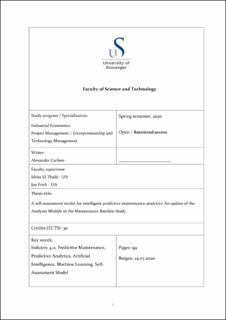A self-assessment model for intelligent predictive maintenance analytics: An update of the Analyses Module in the Maintenance Baseline Study
Master thesis

Åpne
Permanent lenke
https://hdl.handle.net/11250/2682157Utgivelsesdato
2020-07-14Metadata
Vis full innførselSamlinger
- Studentoppgaver (TN-ISØP) [1459]
Sammendrag
Today's industrial era is rapidly changing due to digitization of information and automation of work processes. Digitalization is disrupting several industries and the vision of fully autonomous production facilities, also known as Industry 4.0, is becoming more and more likely every day. In all manufacturing and production facilities maintenance is a core activity to secure reliability, availability, and safety. This is a wildly accepted truth in asset heavy industries and digitalization projects in multiple industries have been started to take advantage of available technologies. For the oil and gas (O&G) industry, digitalization has focused on making assets smart through sensing technology and digital control systems.
On the Norwegian Continental Shelf offshore oil and gas platforms are well equipped with condition monitoring equipment that collect performance- and health data continuously. The problem arises when analyzing aggregated data as decision support for maintenance planning. Trending and subjective opinions are still the most used methodologies even though artificial intelligence (AI) and Big Data analytics could improve this task significantly. AI has the potential to screen huge quantities of data and discover patterns, correlations and calculate statistical possibilities which would improve fault detectability, fault recognition (i.e. diagnostics) and remaining useful life and degradation rate (i.e. prognostics) accuracy. To implement predictive AI analytics there are a set of predetermined requirements that need to be included in the maintenance work process. However, the state-of-practice self-assessment methodology (i.e. Maintenance Baseline Study) does not include state-of-the-art technologies such as AI and ML analytic tools, nor maintenance strategies as predictive maintenance.
Thus, the purpose of this thesis is to develop a new self-assessment model where readiness to implement AI analytics is the governing theme. With the Analyses Module in the Maintenance Baseline Study as a benchmark, the goal was to develop an easy to use, accessible and up-to-date self-assessment model that allows companies to assess their readiness to implement AI analytics tools related to a predictive maintenance strategy. The updated self-assessment model was developed after a thorough literature review of operation- and maintenance theory and Industry 4.0 enabling technologies. This theoretical background formed the basis of the new model, and further developments helped achieve the following improvements:
1. An online self-assessment platform provides accessibility from any device connected to the internet.
2. Multiple-choice reduces complexity, assessment time and provides all responses in a quantitative format which simplifies group / industry analysis if desirable.
3. The models focuses on predictive maintenance and AI technologies are visionary, i.e. the insight received by conducting the self-assessment is essential information for building a system for predictive analysis.
An important part of model development was review and feedback gathering from operation- and maintenance professionals. Through an iterative process of review, feedback and updates, the model was highly influenced by industrial expertise. This was an important measure to secure its validation, and to verify its value.
Beskrivelse
Master's thesis in Industrial economics
